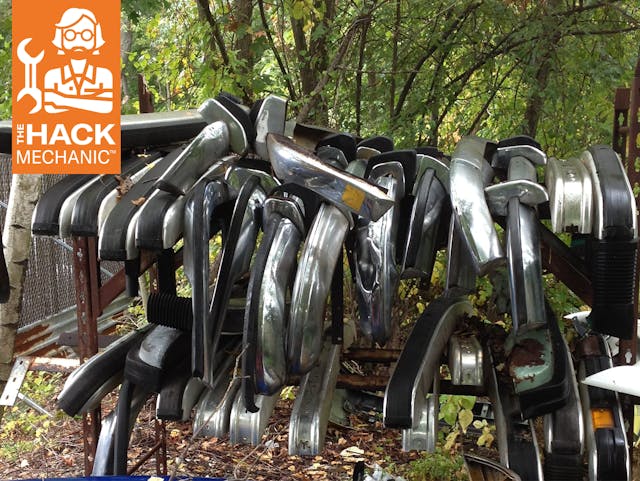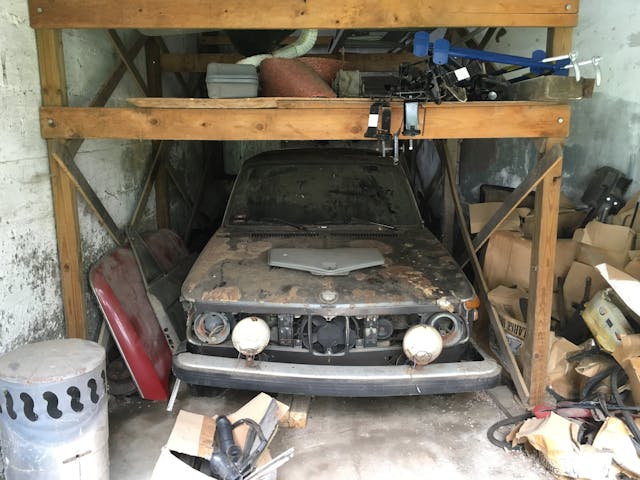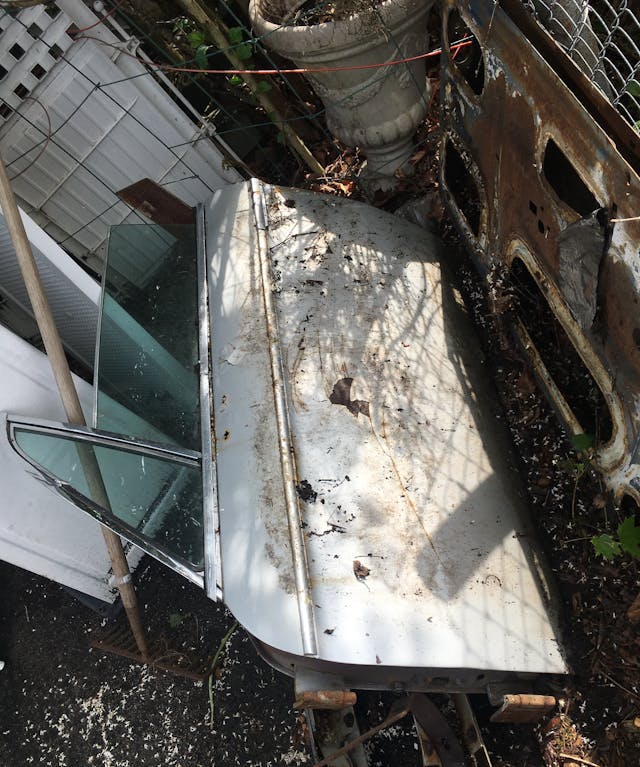Media | Articles
Keep, sell, or toss? Thinning the parts stockpile is like prepping for a garage sale

While I resolutely deny that I am a hoarder, I’ll admit that I have certain hoarder-like tendencies. They derive from two events I participated in 32 years ago with my just-restored 1973 BMW 3.0CSi E9 coupe. To aid in that car’s restoration, I bought a wrecked 2800CS parts car and stripped it. Anyone who’s ever done this learns that an assembled car is the perfect vessel to hold its parts, and that when you strip it, the parts explode to a hundred times their original volume.
So when someone begged me for the driver’s side door glass, and someone else needed a rear bumper, I happily sold them what they needed. A week later, another E9 coupe I owned had been lightly rear-ended at a stop sign, so I regretted having sold the bumper off the other one. A few days after that, I slammed the door shut, forgetting that, after the restoration, the body shop hadn’t properly adjusted the door glass. I watched in horror as the top of the glass caught the edge of the drip molding and crumbled into a million pieces.
“That’s it,” I said to myself. “I’m never selling anything else.” And so, for decades, I erred on the side of holding onto parts. You know, just in case.
The parts from that 2800CS, along with other parts from another E9 coupe and two BMW 2002s that I parted out, accumulated under the front porch of the three-family house that my mother owned in Boston (my mom, my sister’s family, and me and my wife lived there together for eight years). The parts remained there for decades after we moved to our current house in Newton, Massachusetts, in 1992. About four years ago, my mother gently asked me—for the third time—to clean things out. I put out the word, mostly on Facebook, that I was having a haul-it-away-for-free-no-shipping-no-exceptions sidewalk sale. I got rid of doors, differentials, gearboxes, and more, then packed what remained into my Suburban and hauled it off to Newton.


Not long after that, I helped a friend buy a 3.0CSi project that was being sold by the owner of a nearby German car restoration shop. I learned that the seller was closing the shop and getting out of the business, and I wound up buying three Suburbans full of vintage BMW parts, including some sheet metal, a few boxes of new old stock (NOS) parts, and literally 12 bumpers.
Marketplace
Buy and sell classics with confidence

A few years later, as I wrote here, I bought back “Bertha,” the BMW 2002 I’d owned for those years when I lived in my mother’s three-family and sold to a friend shortly before we moved. It had been stored in his neighbor’s garage for 26 years. My friend’s parts-hoarding tendencies were perhaps even worse than mine, so a mound of parts had to be dealt with to even begin to move the car. I threw out the obvious junk and gave away six—six—four-speed transmissions, as I already had two known-good ones, but nearly everything else came back to Newton.

These three events—the moving of my own stuff from Boston, buying the parts from the closing body shop, and having to deal with the hoard that came with Bertha—created a parts tsunami in my house that I’ve never recovered from. And that’s in addition to the stuff I’d accumulated from the normal rhythm of owning the seven vintage BMWs and the Lotus Europa. The basement, the garage, the area under the deck, and the end of the driveway were all crammed to the bursting point with stuff.
While you hate to toss something you might need, it reaches the point where you have so much stuff that space becomes the valuable commodity and you’re willing to—rather, you’re forced to—dispose of some of the hoard, even if it means that there’s some possibility you might have to go out and pay money for something you’ve just discarded. (Note: If you do this, you’re not actually a hoarder; you’re just someone who recognizes the value of a good used muffler.)
While I was getting tired of tripping over the intake manifold left over from a project I did 20 years ago, the specific impetus for me do something came in an unexpected way. The paint on the trim on the garage was peeling badly. My son offered to strip and paint it, but my Winnebago Rialta RV, which lives at the end of the driveway, was in the way. I started it up and moved it 20 feet forward, and that exposed what even an enthusiast would admit looked like a junkyard. It was time to look the parts beast in the face and, if not kill it, at least sedate it.

There are a few ways to deal with a parts hoard that’s gotten out of the control. The nuclear option is, of course, to simply junk it all—rent a dumpster, call 1-800-GOT-JUNK, or make 20 trips to the local recycle depot. However, those of us who love the cars for which we’ve accumulated parts have a tough time with such an indiscriminate approach; the idea of good parts that someone might want being tossed is too much. So, instead you wind up trying to separate the wheat from the chaff and find a good home for the wheat.
The holy grail is reducing the hoard and coming out of it with some spending money. Anyone who has ever had to go through this knows that the basic dynamic is that 10 percent of the parts may be of value, and the other 90 percent are rarely worth the time to clean, photograph, describe, advertise, pack, and ship. If you’re just satisfying the impulse to keep good parts out of the landfill and put them in the hands of someone else like you, that’s great—like-minded enthusiasts will love you for it, and the great cosmic pay-it-forward wheel probably will reward you—but boy it’s a lot of work to do for no financial reward. So you try to concentrate on the things that you know actually have value.
Here’s a great example. When I bought the inventory from the closing body shop, I went through it and found a pair of NOS dead-mint BMW 2002 round taillights and chrome front grilles in their original boxes and wrappers. Because of my knowledge of this model, I know that these are high-value parts. As a plus, they’re relatively small and light and easy to ship. I photographed them and put them on eBay with high but market-reasonable Buy It Now prices, sold them in a day, and recouped my investment on the entire stash. However, that stash had included an entire left rear quarter panel for an E36 3 Series two-door, brand new with the BMW part numbers on it. It was still at my house two years later. I posted it on E36 forums, dropping my asking price down to free, and still had no takers. It eventually wound up in the recycle bin.

The 12 bumpers are another good example. Brightwork for vintage cars is only of value if it’s, well, bright. The four bumpers that were shiny sold quickly, but the other eight, which had dings and corrosion, have been languishing for years. Although vintage bumpers aren’t heavy, they’re oddly shaped. If they can’t fit in a bicycle box (and wrap-around bumpers can’t), they’re so expensive to ship that buyers don’t want to pay for something less than mint. If you don’t mind the risk of damage, you can simply wrap bumpers in bubble wrap, but for a shipping quote, you still need to specify the size of the rectangular box that would hold them, so it’s still expensive. One buyer requested that I disassemble a three-piece bumper to hold the shipping costs down, but I was stymied by seized and stripped fasteners, and using heat to loosen them runs the risk of discoloring the chrome and melting the rubber trim strips. In the end, I did break several of them down, but not to lower the shipping costs—it was to sell the sections where the chrome was good and recycle the corroded ends. Money-wise, it was a fool’s errand, though I’m sure the folks who bought the individual pieces for short money were glad to have them.

Of course, body parts are difficult to ship, either due to fragility or weight or both. I had two 2002 trunk lids, two doors, and two sets of fenders. Since 2002 body panels are either insanely expensive or no longer available, I had very good luck getting rid of them locally through 2002-specific regional Facebook groups. I first scoured eBay, looking at both auction prices as well as selecting “Completed Listings” so I could see what actual selling prices were, to get a good idea of market value. I priced things fairly and sent anyone who was interested a video of me running my phone over the body panels, which is much more revealing than still shots. I refused to play the “what’s your best price” game online, but I was happy to haggle with anyone who actually showed up. One guy drove down from Vermont, ostensibly to buy one trunk lid, and left with it, two fenders, a door, a set of basket-weave wheels, and other stuff I threw in for free.
For other low-value bulky parts, I eventually settled on a good process, which was basically two strikes and you’re outa here. Certain parts, like three sets of 2002 steel wheels I’d accumulated, a rear subframe, the original big diving-board bumpers off Bertha, and doors with some rust, I offered for free through regional Facebook groups. If there were no takers, I then took a whack at shipping some of it, with the caveat that, once I’m putting in real summer hours dismantling and weighing and measuring, it’s no longer free. I saw other eBay sellers hawking big bumpers for $200 a pop, but hawking isn’t selling, and when I couldn’t give them away locally and couldn’t eBay them for a $19.95 starting bid and actual shipping costs, into the recycle bin they went.
An inordinate amount of time went into disposing of the fully loaded door from that 2800CS I’d parted out 30+ years ago. The door was rusty and had clearly visible bondo, but these days, with body panels for E9 coupes unavailable, it’s not unusual for a body shop to combine pieces from two or three panels to make one good one. I figured someone might want it. I offered it for free locally and had no takers. Someone asked if I’d ship it, but it was too big and heavy to go anything except freight. I offered that if they made all the arrangements, I’d strap it to a pallet, but that didn’t happen.

So I spent several hours in the hot sun disassembling the door, pulling the tracks, regulator, glass, and locks out of it. I verified that the bare door now could fit into a bicycle box, and, like Bertha’s bumpers, I put it on eBay for a $19.95 starting bid plus actual shipping. When I had no takers, I took it to the recycle bin with a clear conscience. I did have someone contact me wanting many of the internals (in fact the fellow who asked about shipping the whole door), which now that they were free of the door, were inexpensive to ship. And I kept the door glass for myself. Just in case I smash mine again, or someone has a thing against E9s the next time I park it somewhere. Not a bad resolution.

If you’re going to put low-value parts on eBay, and if the goal is simply to move them along at any price, the key is to be efficient about it. A few photos and a short description containing the part number can be thrown together quickly. The time-consuming part is often determining the shipping cost. USPS Priority Mail Flat-Rate boxes work well if the item is small enough to fit. Otherwise, you need to either guestimate the shipping (and for large/bulky items, it’s easy to underestimate), or find a box and then weigh and measure the package as part of penning the auction. Buyers do like to see that you’re charging them, for example, an actual UPS Ground or USPS Parcel Post rate to their address. But man, all of that takes time.
As I said, so much of this is knowing the car and the community well enough to know which parts have real value and thrn put time into moving those. I’d given away three sets of 2002 steel wheels and sold a set of alloys and good snow tires for $100 because I wanted them gone, but among the multiple sets of nasty-looking old wheels was one set of 5×13-inch wheels from a fuel-injected 2002tii. That’s significant because the tii had better brakes than the stock 2002, including larger front calipers, and those require wider wheels to clear the calipers. Eventually all 2002s received a different style of 5-inch wheels, but for ’72 and ’73, it was only the tii that had them. Back in the day, many owners tossed their original 5-inch steelies in favor of aftermarket alloys. Now, of course, as these cars have increased in value, the market values originality, and a search on the enthusiast forum bmw2002faq.com revealed that people asking $800 for tii steel wheels had buyers lining up. I knew they had value, but I was surprised they had that much value. Hey—I was giving away other parts. I didn’t have a moral issue in maximizing my take on this one item.

In order to bring all the money, though, I’d need to clean the wheels, then ship them to a desirous buyer, which meant breaking the old dry-rotted Comp T/As off and having the rust sandblasted. Before putting the time into doing that, I first tried the easy way out, which was posting them on the local 2002 Facebook page for $600. I had no takers, so I paid to have the tires dismounted, and tried to find a good price on sandblasting. While I was waiting for quotes, though, I gave each of them a coating of naval jelly (phosphoric acid), worked it with a wire wheel on a drill, and power-washed it off. They cleaned up enough that I put them on a nationwide 2002 Classifieds Facebook page, and to my surprise they were sold in a few hours to a buyer in Seattle.

Of course, I then needed to deal with shipping. I very rarely pay for boxes, but I wanted to get the wheels packed and en route. I found online that U-Haul sells a “medium” 18x18x16 box that seemed perfect to hold two wheels. I verified that a local U-Haul had them, then drove there and picked them up. I then packed and weighted the boxes and got accurate quotes from USPS Parcel Select, UPS Ground, and Fedex Ground. Often there’s very little difference between the three, but in this case Fedex was substantially less expensive. They’re also farther away from me, but with the buyer paying close to market price, I was trying to get him the least expensive shipping possible

This was a good start. A lot of big bulky items got disposed of, some stuff free went to good homes, some body panels to someone who was thrilled to get them for a fair price without having to pay shipping, and a very rare set of wheels to someone who’d been looking for them and pounced on the opportunity.
Now if only I could bring myself to throw out the box full of seat belts and the seven windshield washer bottles I keep having to walk around.
***
Rob Siegel has been writing the column The Hack Mechanic™ for BMW CCA Roundel magazine for 34 years and is the author of five automotive books. His new book, Resurrecting Bertha: Buying back our wedding car after 26 years in storage, is available on Amazon, as are his other books, like Ran When Parked. You can order personally inscribed copies here.













